
Crime Photos and Singing Monks – A Spectacle of Sight and Sound
Sep 17, 2016 // Janet Hsu
Welcome to another development and localization blog for Spirit of Justice! Is everyone having fun with the “Phoenix Wright: Asinine Attorney” mini-episode and its accompanying pixel art theme? I really love both of these side stories (Apollo’s is available next week!) for their over-the-top insanity and silliness, but I’ll let you be the final judge of that!
This week, I’ve got Mr. Horiyama and Mr. Fuzii on deck. They’ll be sharing stories about their work on the sound design and 2D illustrations of this game. And then, I’ll be sharing a little about how we localized their work into the final version you see in the game.
And now, here’s Mr. Horiyama!
After the Morning Dance of Devotion~⒪
Hi, everyone. I’m the sound director of Spirit of Justice, Toshihiko Horiyama.
From Noriyuki Iwadare’s to the Capcom Sound Team’s work on this title, there is a virtual cornucopia of gorgeous music and sound effects that they created for the American and Khura’inese courtrooms that I would love to point out to you, but the most trying, the most enriching, and the most memorable bit of work was when we poured our hearts and souls into the creation of the sound data for each and every one of Pees’lubn Andistan’dhin’s singing testimonies in Episode 1.
My work on creating that large amount of sound data started around the time when the game designers came to me and asked if they could somehow have Andistan’dhin’s testimony display in time to the music. I received a sample of a typical Andistan’dhin testimony from them, and treating it as a set of lyrics, I created A, B, and sub-melodies, turning the sample testimony into a stock song – a sort of base to draw on later. Many of Andistan’dhin’s testimonies consist of five or six text windows, so what I did was take one of the base melodies I’d created and adapted it so that each statement of the testimony would sound like that melody’s original lyrics. In the event that the text (lyrics) and melody wouldn’t mesh, I would change the text slightly without changing its meaning until it fit just right.
Next, I placed markers that corresponded to the lyrics within the wave data of the completed melody. These markers were for the game’s programming so that it would know when to display what bit of the “lyrics” on the screen as the song was playing. For example, for the line “After the morning Dance of Devotion”:
Marker 1 – Af
Marker 2 – ter
Marker 3 – the
Marker 4 – mor
Marker 5 – ning
Marker 6 – Dance
Etc.
Here’s an example of how I went about marking the sound data.
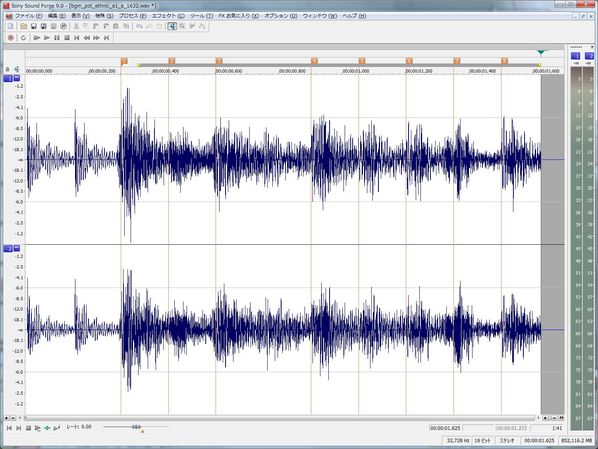
With this sound data in hand, the scripters were able to then insert the scripts necessary into the text of the testimonies to make the letters display when they’re supposed to in time with the music. The presentation lead, Mr. Onishi, touched on this a little in his entry about scripting . Once this was all done, we implemented the sound data and scripts into the game and tested it out. We fiddled with and adjusted some things a number of times to get the text and music to line up correctly, but as things started falling into place, we were able to basically lock down and mass produce all of the sound data we needed for Andistan’dhin’s singing testimonies.
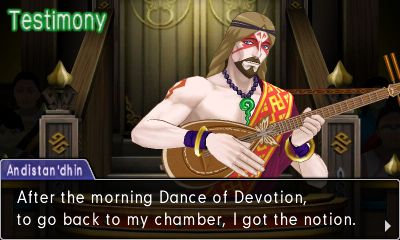
There are a number of these singing testimonies – in fact, there are 41 of them to be exact. I made 41 unique pieces of sound data (and melodies) for these lines of lyrics.
“It was that muggy, hot summer of last year when
Day in and day out, I made songs for Andistan’dhin”
——————————————–
Thank you, Mr. Horiyama for this in-depth look at how you were able to bring us such a unique style of giving testimony!
It’s funny that the Japanese version started with the lyrics and Mr. Horiyama composed around them, because in the English version, we had to do the exact opposite and write lyrics that didn’t change the meaning of the text and that still fit the music! Naturally, we also had to redo the scripting since English consists of syllables of multiple letters rather than individual kanji and kana characters. I thank my fellow localization team members for all the work that went into THAT unique and daunting challenge!
Speaking of another daunting challenge, do you remember how many 2D illustrations you saw throughout Spirit of Justice? Well, here is Mr. Fuzii to share a little about all the hard work that goes into drawing all of them!
—————————————————-
On Drawing 2D Illustrations
Hi everyone! I’m Norihide Fuzii. This is my third outing on an Ace Attorney game, the other two being Apollo Justice: Ace Attorney and Gyakuten Kenji 2. I was in charge of making character models, drawing 2D and mini-character illustrations, and a whole bunch of other things.
Today, I’ll be sharing a little about my 2D illustrations work.
On the Ace Attorney team, we call the 2D illustrations that we use at key points in the story “event cuts.” These include pictures of things like in-game photos, letters, and other story-supporting elements, to major things like illustrations of the exact moment of the crime or of a certain thing we’d like you the player to be able to clearly visualize.

Illustrations like these…

…and this…
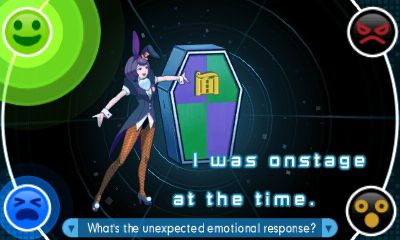
…and even these pictures in the Mood Matrix are a part of what I do.
And now we come to the meat of my story: without spoiling anything, I’m going to show you how I draw these illustrations with an example from Episode 1: the Crime Photo.
2D Illustrations from Start to Finish
Step 1
A request arrives from the game designers. With it is a detailed diagram with notes regarding when and how the illustration will be used in the story and, in the case that the illustration is part of a puzzle, any guidelines and stipulations on things such as what I can and cannot show in it.

Illustrations that serve as in-game photos are almost always heavily tied to the story or one of its puzzles, so it’s always a real challenge to create them because of how many conditions I have to keep in mind.
Step 2
I draw a rough version of the illustration based on the request order while paying particular attention to the perspective of the people, backgrounds, and any other objects within the frame and the illustration’s overall composition.

Everything slowly comes together as I fine-tune and adjust each element of the picture.

Step 3
As I work on the illustration, the game designers and the art director Mr. Fuse check on my progress to give me feedback and to make sure we’re all on the same page. After all that, surely I’m really close to being done, right?
But no! During the process of tuning the game’s difficulty, I suddenly received a request for me to fix something in the picture!
“The gun and the scroll are too hard to see in the picture, so please make them stand out a little more,” I was told.
This type of adjustment work is super important as it’s tied to how difficult the game, and therefore, how fun or frustrating the game will wind up being.
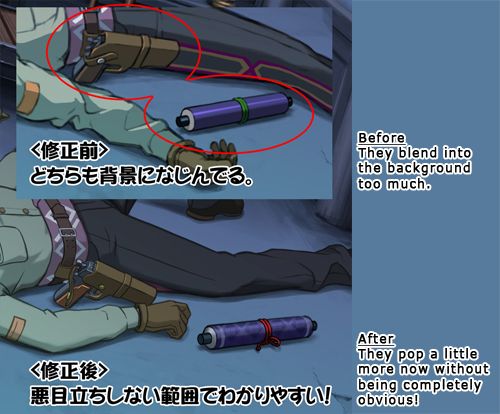
There! Fixed! Next!
Step 4
I’m finally done!!!!!
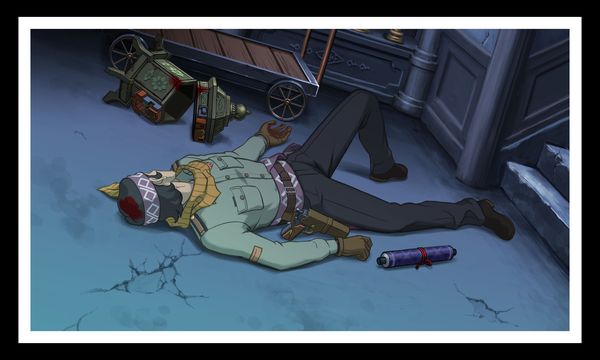
…Or so I thought. But no! This time, there was a request to change a real fundamental aspect of the illustration!
“We need you to please change the positioning of his left hand and the blood on it,” I was told.
Ah, there’s a discrepancy between what the game wants the player to point out and what the picture actually shows. These kinds of fixes are a really, really big deal.
Step 5
I’m finally done for real this time!!!
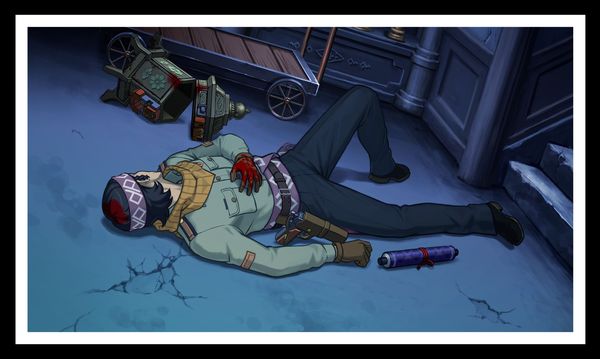
Brushed the picture up a little more for artistic reasons, and now, it’s perfect!
–FIN-
And there you have it! I think you can see just how much time and work goes into creating just one of these illustrations.
Because the character models and animations in Spirit of Justice are even better than they were in Dual Destinies, those of us in the “event cut” section were determined to not lose to them, so we worked extra hard on our illustrations, too! This time, we didn’t draw just secondary illustrations for things like crime scene photos and other pieces of evidence, but lots and lots of important and dramatic scenes as well.

I would be truly honored if there were any illustrations among them that resonated with you.
Thank you for your support of the Ace Attorney series, and I hope you’ll continue to enjoy the series for years to come.
———————————————–
Thank you, Mr. Fuzii for that great example of how you and your section members draw the many, many gorgeous illustrations in this game.
Mr. Fuzii mentioned that among the illustrations he worked on were the ones for the various pieces of evidence. I’d like to share a story of one of the things we had to localize for Spirit of Justice. Without spoiling anything, I’d like to use an example from the beginning of Episode 3.
In Episode 3, The Rite of Turnabout, Phoenix gets a guidebook from Ahlbi as soon as the episode starts. Here are the thumbnails and illustrations for that piece of evidence.
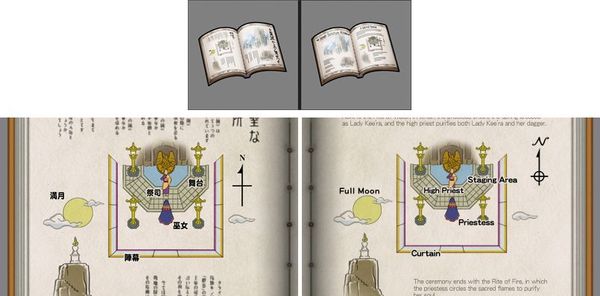
Japanese versions on the left, English versions on the right.
Because the guidebook is for English-speakers in the localized version, the book had to first be reversed in the thumbnail, as the Japanese version is laid out as a right-to-left book (it didn’t have to be – the majority of books in Japan are actually left-to-right nowadays – but it’s what the dev team chose).
After the layout was reversed in the thumbnail (thank you Ms. Kobayashi!), Mr. Fuzii took it as a rough outline of how he should lay out the detailed illustration.
Aside from the obvious editing of the Japanese to English, there is one other thing you may have noticed that changed. I’m sure you can figure out by context what it is, but imagine if you had just this illustration to work off of in the final version of the game.
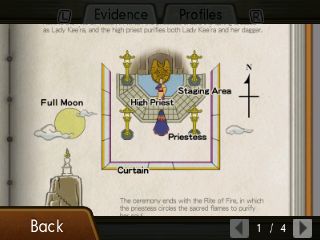
At one point, this was going to be the final version, but as we playtested it with some members of our localization team, a few people were unsure what the cross with the N on top meant (if they could even read the N on the lower screen). That’s when it hit me: this is a Japanese style compass and I had grown so used to seeing it in Japan that I didn’t even need the N at the top to know what it was!
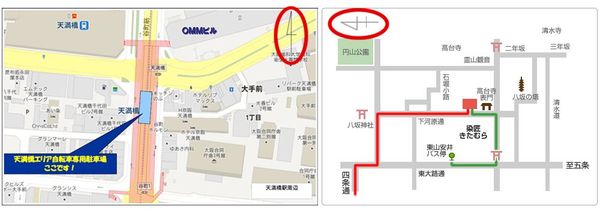
Japanese maps often don’t even label the N or 北 ( kita ) since it’s common knowledge what this “4” shaped thing is.

But in the context of an English map, with all those English letters flying around, the compass became this odd cross that’s just in the upper right corner for no apparent reason. A quick internet search shows that in the West, one essential component in the design of a compass is the presence of a circle or at least the suggestion of a circular shape (by including NE, SE, SW, and NW, for example). It’s one of the ways we recognize something as a compass.
That’s when I made an adjustment request of my own to Mr. Fuzii to add the circle to the cross, and to make sure that the N was more visible and stylized differently so that it wouldn’t get lost in the diagram. After all, it wouldn’t be fair to you, the players, if you had to figure out something that wasn’t actually supposed to be one of the puzzles in the game!
Join me next Friday for a look at character model creation and animation! As Mr. Fuzii pointed out, I think you’d agree that the models and animations this time have really been spectacular, so stop on by next Friday after some Apollo Justice: Asinine Attorney fun for a behind-the-scenes discussion!
Until then!
Catch up on previous blog entries here!
-
Brands:Tags:
-

Loading...
Platforms:


